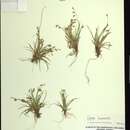en
names in breadcrumbs


Typical plants from the western part of the range have perigynia 2.2–3.3 mm with a smooth beak. Plants from the east, which have been recognized as Carex karusei subsp. porsildiana (Polunin) Á. Löve & D. Löve, have perigynia 1.3–1.8 mm and, sometimes, a serrulate beak.
Plants from the east and west coasts of Greenland, which are more robust than typical Carex krausei and usually have a serrulate perigynium beak, have been described as C. boecheriana Á. Löve, D. Löve, & Raymond [C. capillaris subsp. robustior (Drejer ex Lange) Böcher]. The chromosome number 2n = 56 has been recorded for these plants (Á. Löve et al. 1957).
The status of Carex krausei is far from clear, and many authors have treated it as a variant of C. capillaris. None of the morphologic characteristics by which they are distinguished appear to be reliable, and the relationship between chromosome number and morphology is based on examination of relatively few populations. This relationship is further confounded by C. boecheriana, which is morphologically similar to C. krausei, but cytologically closest to C. capillaris. There is no evidence of an ecologic difference between C. capillaris and C. krausei; across its range, C. krausei is sympatric with C. capillaris.
Carex krausei, commonly known as Krause's sedge or carex de Krause in Canada,[1] is a tussock-forming species of perennial sedge in the family Cyperaceae. It is native to subarctic areas of Greenland, Alaska, northern Canada and Russia.[2]
The sedge has 15 to 35 cm (5.9 to 13.8 in) long culms with flat to folded leaf blades that are 2 to 8 cm (0.79 to 3.15 in) long and 1 to 2 mm (0.039 to 0.079 in) wide. The terminal spike contains both staminate and pistillate and is 7 to 10 mm (0.28 to 0.39 in) in length and 1.3 to 1.5 mm (0.051 to 0.059 in) wide in the staminate part with lateral spikes over the top. There can be four to ten lateral spikes containing 10 to 20 flowers.[3]
The species was first formally described by the botanist Johann Otto Boeckeler in 1886 as a part of the work Botanische Jahrbücher für Systematik, Pflanzengeschichte und Pflanzengeographie.[4] There are four synonyms;
There are also two subspecies;
It is found in sub arctic to temperate biomes in the northern hemisphere. It is found in Alaska and most parts of Canada including Yukon, Nunavut, the Northwest Territories and Quebec in the north down to British Columbia, Manitoba and Ontario in the south. It is also found in Greenland. In Russia the range extends from Chukotka Autonomous Okrug in the east through northern European Russia to Northwestern Federal District. It is also found in Svalbard further to the north.[2]
Carex krausei, commonly known as Krause's sedge or carex de Krause in Canada, is a tussock-forming species of perennial sedge in the family Cyperaceae. It is native to subarctic areas of Greenland, Alaska, northern Canada and Russia.